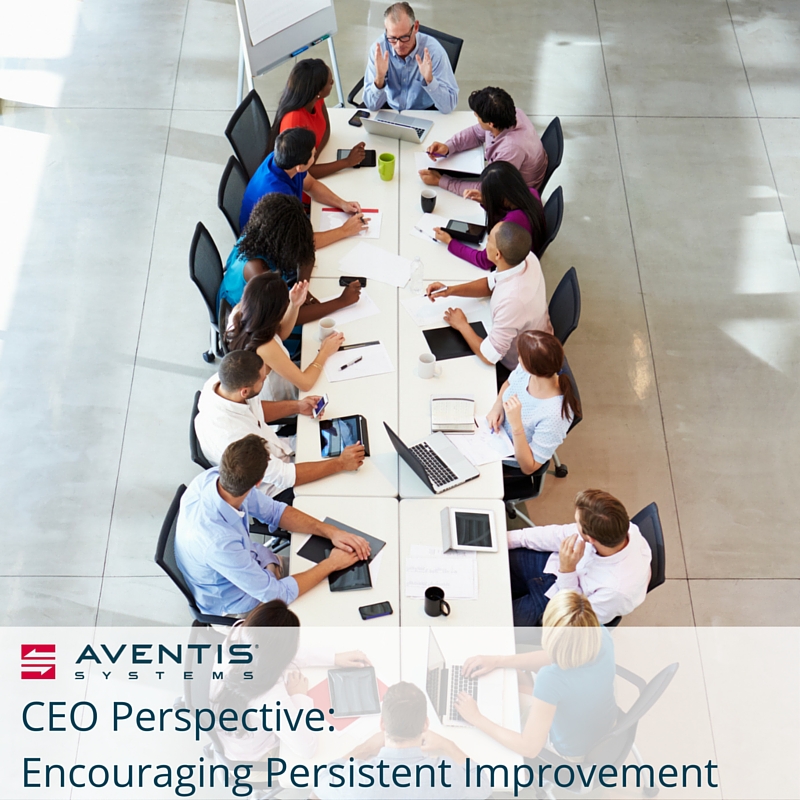CEO Perspective: Encouraging Persistent Improvement
by Hesam Lamei

Promoting a culture of continuous improvement is a popular topic in the professional world. In a nutshell, a culture of continuous improvement is a constant drive of process improvement in the workplace. One reason HR professionals and leadership teams discuss this topic on end is because continuous improvement is a vital ingredient to success. In this blog article I provide tips for leadership to instill continued improvement into company cultures and personal examples of success after making persistent improvement a business priority.
According to KaiNexus, there are several key steps for leadership to implement a culture of continuous improvement. To begin with, CEOs should be a walking example of constant improvement and promote the concept with every interaction by sharing ideas. Leadership participation and support are vital when implementing a shift in company culture. Next, leadership should seek out feedback for improvement and take action quickly to address the feedback. Also, make sure the areas for improvement stretch beyond things that directly affect revenue. When promoting a culture of continuous improvement, it is important to equip personnel to incorporate daily improvements into their work and encourage small, incremental successes to keep morale high. Finally, encourage and help employees get excited about continuous improvement by compiling successes and celebrating all achievements.
Throughout our company history at Aventis Systems, persistent improvement has been a top priority through our open door policy for internal and external feedback. As part of our 2016 rebranding, we defined persistent improvement as one of our company values because it plays an important role in how we do business. We have several examples of how our strive to constantly improve has impacted our company success.
We witness our product quality improve every single year. Product quality for our company is driven primarily by new rather than refurbished component purchases. This is challenging because new components cost more and hurt margin. In the end, improved customer experiences from lower failure rates, and subsequent lower RMA rates, balance out the lower margin.
Another business area where we see continual improvement each year is shipment quality. Our Operations team has troubleshooted shipment challenges over the years and now follow suit with how original equipment manufacturers ship products. Our team has learned the major drivers for successful shipments include procuring different box sizes and types based on the equipment sold as well as using molds rather than chemical sprays to protect equipment. The key drivers present challenges because they cost us more in supply expense and take up more storage space in our warehouse. However, these challenges balance out with a better customer experience from lower damage rates and lower RMA rates.
Our prioritization of persistent improvement has also yielded successes in quality control. Originally, our quality control was the sole responsibility of our Systems Technicians. We now utilize a three-layer approval system consisting of a Systems Technician, Head Technician and Operations Manager. This process improvement in Quality Control again has increased costs due to increased management and higher salaries, but as mentioned previously these costs balance out with the improvement in customer experience from lower failure rates and related lower RMA rates. Additionally, this process improvement has created an opportunity for continual training of technical subordinates as they learn how to correct their mistakes, and thereby has raised the calibre of our technical staff.
A final important area of business impact from our culture of continual improvement is a lower turnover rate of our Sales staff. Several process improvements within our Sales department can be credited for this success. First, our Sales department now focuses more on quality of hire and culture fit from the get-go, and a peer mentorship has been implemented for the first 60 days of employment to improve the new hire experience. Secondly, the department revamped the compensation structure for base, bonus and commission. Lastly, the Sales team has increased opportunities for professional development and team building. Even though all aspects of change have presented increased costs, the lower turnover rate has improved the customer experience through better relationships with consistent representatives, and has increased customer trust in our brand.
A culture of continuous improvement can start with small efforts toward process changes as personnel become familiar and comfortable with the culture shift. As the company takes on this proactive way to perceive challenges, leadership should continue to be the cheerleader of the movement and watch as larger successes unfold.